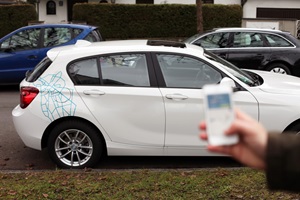- Fuel Efficiency and Emerging Technologies
- Transportation Efficiencies
- Carsharing
Zipcar Adds One-Way Carshare Service

Zipcar had been running a beta program in Boston for 2 years, with 200 vehicles available for one-way service. In Guidehouse Insights’ 2015 Carsharing Programs report, I predicted that Zipcar would adopt this service model in more cities, as one-way service has been one of the biggest disruptive trends in carsharing over the last several years. The other major disruptor in the market is related to one-way service: the entry of automakers in earnest into carsharing programs. Daimler and BMW are the two biggest automotive players in carsharing, and since launching their respective programs, the two companies are capturing a significant portion of the total global carshare membership as of the end of 2015. Both of these programs, Daimler’s car2go and BMW’s DriveNow, are one-way services.
BMW and Daimler seem to have grown by expanding the carshare market, not necessarily by taking market share from incumbents. Zipcar is one of the biggest carshare companies globally, operating in over 400 metropolitan areas in North America and Western Europe, with approximately 900,000 members as of the end of 2015. The vast majority of these members are in North America, where Zipcar is the biggest player in carsharing. However, Daimler and BMW have made claims to having over 1 million and 300,000 members, respectively, even though they operate in only a fraction of the cities that Zipcar does.
Rapid Expansion
This rapid expansion reflects the new opportunity that one-way service presents for carsharing market growth. One-way opens up a different use case than the traditional carshare model of picking up and dropping off a car in the same parking spot. In some respects, one-way service looks more like an Uber or Lyft or other ridehailing type of mobility service. Users can make more spur-of-the-moment decisions to rent a car. These rentals become more attractive for short inner city trips which, due perhaps to weather or a lack of public transit or some other factor, are more conveniently done by car. One-way service also reflects the overall changes happening in the urban mobility market, where people in cities are accustomed to on-demand mobility in a range of flavors, including public transit, ridehailing, bikeshare, carsharing, and others.
Not that traditional carsharing operations will fade away. The Carsharing Programs report forecasts that global membership in carsharing services will rise from an estimated 4.8 million in 2015 to over 20 million in 2024, spread across several business models—the conventional model, the one-way model, and even some unique models like the Kandi Technologies vehicle vending machines in China. Traditional carsharing service will still have a role, as it is a comparatively less investment-intensive operation, and will still fill a need case among users to reserve cars for specific appointments and longer distance driving. One-way services do pose logistical challenges, most notably in securing parking, an issue that caused DriveNow to exit the San Francisco market. Nevertheless, one-way carsharing is expected to see faster growth as companies like BMW, Daimler, and Bollore expand their operations. And now Zipcar has joined the trend.